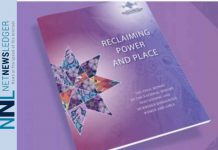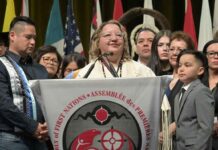 OTTAWA – Leaders Ledger – I’d like to reflect on the promise of section 35 and the potential, to assess where First Nations are now and then set out what I see as the constructive steps to an essential path forward.
OTTAWA – Leaders Ledger – I’d like to reflect on the promise of section 35 and the potential, to assess where First Nations are now and then set out what I see as the constructive steps to an essential path forward.
But first…. before we get into too much detail, I want to begin with a story – a story from my peoples – the Nuuchahnulth. I grew up surrounded by stories and they continue to shape my perspective and those of our Nations across this country – here is a very brief version of the important story of Bear:
A man made a fish trap and placed it in the river. The man checked his trap every day. Each day he found it had been emptied of fish and the trap wrecked in the process. Each day, he repaired the trap and tried again. And yet each day, he found the same result. One day, he decided to wait and to see who was destroying his trap. Sure enough the man saw Bear break his trap and take all of the fish. Man confronted Bear asking why he was doing this. Rather than explain in words, Bear suggested the man accompany him so that he could show him why he was taking the fish. After walking for many hours, Man grew tired, so Bear put him on his shoulders and carried him the great distance to the Bear village. When they finally arrived, Bear gave the fish to the people of his village. The man stayed and observed the way they prepared the fish and all of the many good uses made of the fish. After some time, Bear told the man he would take him back to his river but first the man must meet the chief of the village. At this meeting, an agreement was struck between the man and the Bear Nation. If the man was willing to share the bounty of his catch, there would always be plenty of fish for both the Man’s Nation and the Bear Nation. When Bear returned the man to the river, sure enough the trap was full and half of it went to the Bear Nation and in the agreement, the trap was never destroyed again and both Nations protected the river to yield fish for all in perpetuity.
These stories are the foundation of our Indigenous belief systems and tell critical lessons of our philosophy and perspective on sustainability, on sharing, on respect and the importance of protocol. All of this helps explain our approach and our analysis.
So we look at the achievement of section 35 and what has followed. The Supreme Court of Canada stated that the principle purpose of section 35 was to fulfill the promise of reconciliation between Indigenous peoples (and our rights) and the rest of Canada – not so dissimilar to our story of Man’s experience with Bear and the need for them to reach an agreement. Our question is then: has section 35 fulfilled that promise of reconciliation?
To gauge the effect of section 35, we need to look at how Aboriginal and Treaty rights have been dealt with before and after it was enshrined in the Constitution.
As we all know and have painfully experienced in the past – Indigenous rights have been vulnerable. This is partly because they involve obligations of the Crown – the federal and provincial governments – so they’re highly dependent on the Crown’s good faith – the HONOUR of the Crown. And they’re also vulnerable because our peoples became a minority in Canada.
Before section 35, the federal Crown had much more latitude to infringe or extinguish our rights. Provinces could also infringe on Aboriginal rights, but Treaty rights were more secure because of section 88 of the Indian Act, which makes provincial laws subject to the terms of Treaties.
Section 35 ushered in a major shift in the legal landscape.
First Nations – and indeed all Canadians – should applaud the insight and accomplishments of the leaders who went before us ensuring that section 35 was enshrined in the Constitution. The very fact that they pressed for and won a seat at the table is a remarkable achievement. That they secured recognition and affirmation for Aboriginal and Treaty rights is extraordinary.
But it was clear that there wasn’t the time during those talks, nor was there the political will on the part of Canada, to fully clarify those rights. Our leaders of the day saw that work as the next step.
And still today, section 35 represents unfinished business – perhaps the greatest piece of unfinished business in this nation.
Recognizing and implementing Aboriginal and Treaty rights takes us back to the very founding of this country – a country founded on our lands and politically on peaceful agreements based on respect, recognition, sharing and partnership.
Since 1982, successive governments have shown little interest in the real and hard work of reconciliation. There has been talk, but we know the equation of empty initiatives: talk minus action equals zero.
First Nations though are not standing still – are not waiting. We’re taking action. For decades now we’ve been putting forward positive plans for progress and change, plans aimed at breathing life into the promises we made to one another and plans that will ensure a better future for our children.
Government’s response has often been limited, narrow, piecemeal and unilateral.
In the absence of the honour of the Crown, much of the ground that’s been broken has been through the courts.
The first test was the Sparrow decision in 1990. The Crown argued for a narrow interpretation – that section 35 was an “empty box” that only contained what the Crown was willing to put into it.
The Court took a strong stance against this position, highlighting the words “recognized and affirmed” in section 35. They stated that British policy had always respected Indigenous rights. The Court spoke about the importance of section 35 as a statute and a symbol, saying: (and here I’m quoting excerpts from the decision):
“section 35(1) … represents the culmination of a long and difficult struggle … for the constitutional recognition of aboriginal rights… [and] …provides a solid constitutional base upon which subsequent negotiations can take place.”
They ruled that section 35 is a “solemn commitment that must be given meaningful content,”; that the words “recognized and affirmed” compel action based on a generous and liberal interpretation.
There have been many important Supreme Court judgments since Sparrow. A few stand out because they help give shape to the content of section 35. The 1996 Badger decision consolidated the requirement for broad, liberal interpretive principles for treaties based on the honour of the Crown. The 1999 Marshall decision affirmed a constitutionally protected Treaty right to trade.
The 1997 Delgamuukw decision set out a number of significant principles. It ruled that Aboriginal title – the inherent Aboriginal right to land or territory – is distinct from other forms of Aboriginal rights like hunting and fishing. Delgamuukwalso set out a test for proving Aboriginal title that gives the Aboriginal perspective equal weight, and it reaffirmed the importance of consultation.
It also stated – and this is very important – that the underlying purpose of section 35 is to reconcile the sovereignty of the Crown with the reality of Indigenous nations, the original, self-governing peoples of this land.
It’s worth noting that in Delgamuukw, the Court did not issue a binding ruling on Aboriginal title. Chief Justice Antonio Lamer instead urged the parties to negotiate, concluding with his now-famous phrase: “Let’s face it, we are all here to stay.”
The other two key cases worth noting briefly are the Haida decision in 2004 and the Mikisew decision from 2005.
In Haida, the court said that the honour of the Crown does not permit the Crown to run roughshod over asserted rights simply because they’re unproven. The Court also held that once a right had been asserted, the Crown was obliged to meaningfully consult and accommodated.
In Mikisew, the court applied the Haida doctrine to a Treaty context. The Crown argued that Treaties extinguished rights and there was no duty to consult. The Supreme Court disagreed: the honour of the Crown was at stake because ongoing Treaty rights, like the right to hunt and fish, could still be negatively impacted.
So all of this creates an important direction and affirmation for us and certainly a compelling call for sincere engagement and for reconciliation.
The decisions reinforce what First Nations have always held – we have a say and we will have a say – in any development in our traditional territories and the potential for economic benefits.
This is especially notable when we remember that Canada is largely a resource-based economy. 500 billion dollars of investment and activity is anticipated in the coming decade in resource activity which will take place in and around First Nations traditional territories. To be blunt, this development will not proceed without the full participation of First Nations. We exist. We have leverage and we must be dealt with upfront and honestly.
Let me circle back now to my key question at the beginning: has section 35 fulfilled that promise of reconciliation?
Clearly, the answer is no. But, equally so, it’s still the avenue through which we can and must achieve reconciliation.
Our relationship with Canada has always included core economic aspects – and so too now – action is required in the economic interest of First Nations and all of Canada.
Let me make four points here on the path ahead and the challenge before us:
- Reconciliation will only be achieved when First Nations’ right to self-determination is reconciled with Canada’s assumed authority;
- Reconciliation will only be achieved when First Nations receive a fair share of the economic benefits from our traditional territories and participate as partners in development;
- Reconciliation will only be achieved when we can fully exercise and implement our inherent rights and responsibilities to our citizens and our lands; and finally,
- We must move forward based on mutual understanding, respect, and consent. Recall the story of Man and Bear – a simple story indeed but with profound applications for us all.
To actively engage in this work, we must bring full commitment and full engagement.
We cannot rely on the courts for clarity and change. The real path to change is as – the justices have also affirmed – through negotiation and reconciliation. This is the work that I have been speaking about for over three years now. This was the idea behind the Crown-First Nations Gathering held last January.
For us, this was a first step that set another precedent on the difficult road to reconciliation. The purpose was to re-set the relationship on the proper footing of recognition and respect so that we could build on other important steps including the residential schools apology, and the endorsement of the United Nations Declaration on the Rights of Indigenous Peoples and begin the work of advancing First Nation economic interests and investing in the success of communities and children for a better future for all.
Important commitments were made to advance practical pieces of work on fiscal relations, policy reform, the economy and education. But clearly change does not come easily and all of these efforts are hampered by what First Nations see as ongoing unilateral attempts to affect our rights and intensified pressures on our lands and resources.
Current policies and approaches too often only serve to stall negotiations. It prevents First Nations from benefiting from their collective rights. It impedes the economic and political development that would take us forward to become fully self-governing nations.
The Constitution is the highest law in Canada. We cannot pick and choose which sections and clauses we decide to respect and implement. If we believe in our Constitution, and if we believe in the promises we made to one another in the early days of this nation, it is incumbent upon us to find the way forward.
It’s clear that the current federal policies, fiscal arrangements and negotiation processes are not up to the task.
We can find a path forward – a path that starts with our earliest relations – the Royal Proclamation, the Treaties of Peace and friendship, the pre-confederation and numbered Treaties – the absolute foundation of Canada’s growth and progress as a Nation to section 35 and to the standards set out in the United Nations Declaration on the Rights of Indigenous Peoples.
The work of recognizing and implementing First Nations rights and governments requires a broad-based approach on many fronts.
First and foremost, First Nations need to be directly and fully involved in any process of change. This is consistent with our historic relationship as partners in Confederation and as Treaty partners, and it is consistent with the spirit of section 35. It is high time that the government stops trying to do things for us and starts doing things with us.
We can start by conducting a full review or audit of current federal policies and processes to assess their consistency with section 35. Section 35 calls for “recognition and affirmation” of Aboriginal and Treaty rights. But current policies and processes are based on denial, diminishment and extinguishment.
A section 35 audit would compel changes across a number of areas. The Comprehensive Claims policy is a first order of business and essential to addressing some of the nation’s most pressing economic and environmental issues in the west.
It must be fundamentally reformed to recognize rights as opposed to deny and extinguish rights. Recognition will enable settlement and it will create the possibility for expeditious, fair resolution. Endless negotiation causes wasteful expense and escalates frustration for all. It is high time we got on with the reality of our rights and paved a way – away from conflict – to fairness and prosperity. This is in everyone’s interests… and where legal and moral imperatives have not yet been sufficient to compel action – surely the economic imperative makes this just common sense for any government of any stripe to be compelled to resolve.
The federal government’s existing self-government policy would also not survive a section 35 review. It needs to be repealed and replaced by processes that move to recognize First Nation governments – approaches that discard the hubris of the Crown purporting to grant or prescribe self-government.
Instead, we need approaches that implement First Nation Treaty and inherent rights. On a Treaty-by-Treaty or nation-to nation basis, we must set out a new course – one of commitment, of dedicated energy and of focus to achieve resolution. This new course would give life to a lasting relationship of mutual respect and prosperity.
We can look at a range of practical steps that implement rights and make irrelevant once and for all the legislation and the bureaucracy that has been built up around the failed colonial approaches of the past. Yes – the Indian Act and the Indian Actbureaucracy must be fundamentally and finally eliminated. But here too any attempt to tinker or impose will not work.
Instead, we’ve set out the steps that build on the important work of RCAP and suggest the need for clear, stable fiscal relationships, nation re-building among First Nation communities and capacity building and changes to the federal Government machinery – all of which would in turn give life to and support the recognition and implementation of rights and respectful, mutually supportive governmental relationships.
Let me just break that down a little with some examples that illustrate the kind of things that I mean:
To transform current self-government approaches – new mechanisms or protocols are needed– designed with First Nations – to set out the criteria and procedures to be agreed at a rate and pace acceptable to First Nations.
First Nation governments must be enabled to plan and develop their internal governance systems through constitutional development, and oversee all key functions including citizenship, justice, economic development, health, education and social services.
Moving forward, we must transform the current paternalistic relationship with the current department of aboriginal affairs to give way to specific roles that maintain, monitor and uphold the honour of the Crown.
Specific steps advanced by First Nations include setting a “Code of Conduct for the Honour of the Crown.” The Supreme Court of Canada has repeatedly told governments in a succession of cases – from Sparrow, to Taku River – that the Crown must act honourably in its dealings with First Nations. First Nations and the federal Crown could jointly develop a code of conduct for the honour of the Crown. This would enable us to monitor the Crown’s conduct and identify violations. “Good faith” negotiations are prescribed in law and must become the standard approach to negotiation.
Canada continues to not even have a policy or approach to implement or monitor its Treaty relationship with First Nations, even though the treaties are the founding documents of this country. This is essential and a requirement for the implementation of the spirit and intent of the treaties.
By “spirit and intent”, I am referring to the First Nations understanding of the Treaties, and respecting and recognizing that perspective.
Our peoples have always passed on our perspective through stories and teachings and now there is mounting additional evidence. Last February, I took part in a conference in Treaty 9 territory, around the James Bay area. I learned about the newly discovered diaries of the Government Treaty Commissioner, who led the negotiations with the First Nations. These diaries had been hidden for 100 years.
The diaries contain details on the Treaty-making discussions, including oral promises made by the Treaty partners that are not explicit in the written Treaty. The diaries show that the Crown promised First Nations that they would maintain their right to hunt, fish and trap, and retain their economy and their livelihoods anywhere across their lands and waters.
There is no doubt that this was the pattern for many Treaty negotiations across the country. This has tremendous implications in terms of the rightful sharing of resources and the right of First Nations to govern themselves.
Clearly, we need to come back to the real intention of Treaty, which means honouring the relationship of mutual respect and of a fair share of resource development.
Now is the time for all Canadians to learn the truth about our peoples, our Treaties and our historic and sacred nation-to-nation relationship so we can move forward in partnership.
First Nations are standing firm on our rights and our Treaties. It has been suggested that First Nations must choose between economics or rights – this is a false choice. It is only through recognizing and implementing our relationship to the lands, waters and resources as well as to other governments that we will achieve justice and progress.
We need a new approach to implementing the Treaties and all modern agreements. The work I’m describing requires a fundamental shift. It needs to be supported by changes to the existing bureaucracy and machinery of government.
Don’t get me wrong: we’re not calling for more bureaucracy. The bureaucracy at Aboriginal Affairs alone is already costing us more than a billion dollars, yet the results as the Auditor General pointed out for over a decade have been dismal. What we need a fundamentally different approach as I am suggesting here.
A more efficient, effective and leaner relationship aligned with the principles of section 35.
Rather than an entire Department (a department that outspends every other federal department in legal costs by the way raking up over $100 million in legal fees last year alone), First Nations have put forward a number of ideas for a better approaches including entities like a smaller Ministry of First Nations-Crown Relations, an Office of a Treaty Commissioner and a First Nations Auditor-General – entities not to make decisions and programming to be imposed on our peoples but rather entities to respect and implement our relationship and our respective responsibilities and accountabilities.
All of these efforts are about realizing the promise of section 35, a promise that our Elders and leaders worked tirelessly to achieve. We need to honour their achievement by honouring that promise.
The clock is now ticking, with increasing pressure on lands and resources and increasing frustration and tension. We have seen the tragedies that explode when patience runs out.
We all know the cycle: promises made, promises broken, anger builds, confrontation – then an embarrassed government sets up a task force or commission. It makes recommendations, and new promises are made. First Nations are fed up with this vicious circle. And you should be too.
We all want to believe that Canada is fair and just. But the situation of First Nations is a deep scar on our national soul. It was never intended to be this way.
We made a promise to each other in those early days of contact, a sacred vow to share in the beauty and riches of this land, a vow based on mutual respect, mutual recognition, partnership and sharing.
While the Supreme Court itself said, succinctly, in the Sparrow decision: “We cannot recount with much pride the treatment accorded to the native people of this country.”
We do have positions of strength to build on – and I believe that section 35 remains a key cornerstone of this work – when we add the residential schools apology and the endorsement of the United Nations Declaration – we can move forward through new ways of coming together as we did with the Crown last January.
It is time for Canada to honour its promises and work with us to chart a new path forward. Canada has the potential to set the model for such relations around the world – recognizing and honouring relationships for the mutual benefit of all – but we have much work to do.
This is an era of opportunity. First Nations are the youngest and fastest growing part of the population. We are the future of this country. Strong First Nations make a stronger Canada. If we work together we can raise First Nations education and employment levels up to those of the Canadian average. That alone will add literally billions to the country’s economy and save a billion more in costs related to our poverty and poor health.
It’s time for change. Now is our time. First Nations are pushing and pursuing every opportunity for cooperation. We know there are ways we can work together that benefit all and honour the promise we made to one another.
First Nations want to be full partners in designing a collective future – for our communities and the country as a whole.
I invite all of you to join with us, with First Nations, on this new national dream towards a better, stronger Canada. We can create a brighter future, in the same way that our ancestors came together with a vision of a nation founded on mutual respect, partnership and sharing.
Section 35 and other steps have set our path and this is a tremendous advantage – the road ahead is long and it is difficult – but it is a road we must travel together. When we think again of Bear, we realize that it is story principally about achieving relationship-success – a story of reconciliation with tremendous economic and sustainability benefits for all involved. Its wisdom speaks powerfully to us today and of our work together.
I’ll close by recalling the words of Chief Justice Lamer, that “we are all here to stay.” I would add to those wise words that we are all in this together and together we can succeed.
Kleco, Kleco!
National Chief Shawn Atleo





